Q: I have some old Davis Furniture. What is its value?
A: Many factors are involved in evaluating older furniture, including age, condition, and value to a potential buyer. "Value" can mean one of two things:
- Pricing for resale
- Full insurance/replacement value.
Davis Cabinet cannot give you an appraisal over the phone or by email. However, we can suggest ways to find answers for yourself.
- For resale value, go to the section in this document: "I want to buy or sell some Davis Furniture. What is a fair price?"
- For insurance/replacement, an Official Davis Cabinet Company Appraisal is available for a fee of $85. This may be useful to you for insurance or estate purposes. The appraisal estimates the value of your existing furniture and also provides the replacement cost of furniture that is destroyed or heavily damaged by fire or accident. Go to the section: "How can I get an official Davis Cabinet Company appraisal?"
Q: How can I get an official Davis Cabinet Company Appraisal?
A: Requests for appraisals are not accepted over the phone or by email. Please do not call us for an appraisal. Instead, send a packet of detailed information along with a check for $85 to:
Attention: APPRAISALS
Davis Cabinet Company
505 Crutcher St
Nashville, TN 37213
Be sure to include:
- List of pieces
- Description of each piece
- Hard-copy photos (do not send a CD of digitals).
Make a photo of each individual piece taken from at least one angle. Include photos of specific details if applicable.
Authentication. There may be labels that identify the manufacturer, the wood species, the finish, the style, etc. Please note these in your description or take photos of those labels and include them with your packet. Davis Cabinet has used a variety of labels over the years for our products. If you are unsure of the labels, read the section, "How do I know that my piece is made by Davis Cabinet?" Keep in mind that other manufacturers sometimes copied Davis products, so there are some old "knock-offs" in the resale market.
Your written description should include the condition of each piece, noting any scratches, damaged areas, or structural problems. Please review the section, "How do I describe the condition of a Davis piece?"
In addition to photographs and descriptions, the following information can be helpful to the appraiser:
- Age of the furniture. See the section, "How do I determine the age of a Davis piece?
- Name of the style. Davis Cabinet made dozens of styles of furniture over the years, all with specific names for the style line. Most of the time, the style is not marked on the furniture itself. If your furniture is a family heirloom, someone may remember the name of it. Two older styles are still produced today, Lillian Russell ®, first made in 1931, and Cumberland Valley "!, first made in 1936. You can see these on the web site to determine if your pieces are in one of those two styles. Read the section, "What is the style of my Davis furniture?"
- Stock Numbers. Stock numbers will be helpful, but they changed over the years, so they cannot be used to identify a particular piece with absolute certainty. You may find them in many locations on the furniture, so look inside, outside, front, back, and bottom for numbers.
- Identification of wood species and color finish. These may be stamped or labeled on the back of the piece, inside a drawer, or underneath. If the finish name has a wood species in it (cherry, oak, walnut, etc.), then that is the actual wood used in manufacture.
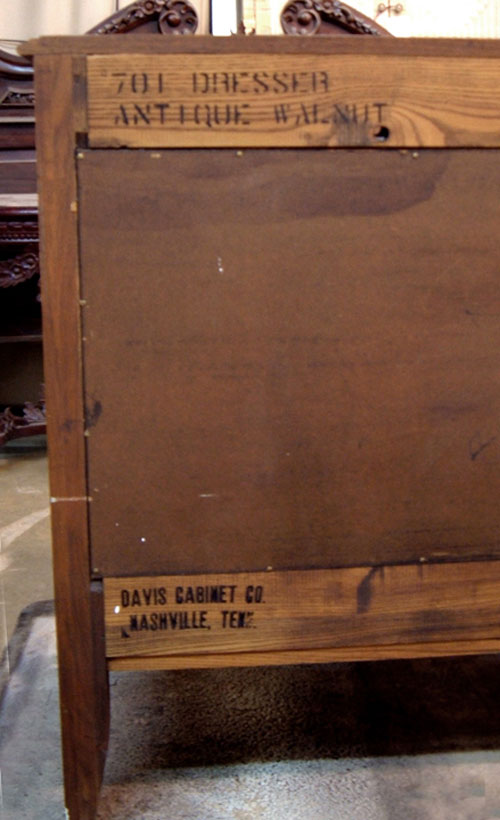
Stamps on back of case 01

Stamps on back of case 02
- Documentation of purchase. Sometimes, family members save such paperwork. It� s worth a look as a guide. Because the paperwork is not tied directly to a particular piece, it can� t be used as firm authentication, but it can sure help.
- History of the furniture. Family ownership? Recent purchase? Any repairs or refinishing?
The official appraisal will be based on the above information. For insurance purposes, the appraiser can provide the cost of replacement of an item. If the piece is no longer in production, the appraiser can estimate the cost to custom build a new piece in the original wood material. The exact hardware used in the original piece may no longer be available today.
Q: I want to sell or buy some Davis furniture. What is a fair price?
A: Fair price depends on what someone is willing to pay for a piece of furniture. The � value� depends on a lot of factors:
Availability and Demand. Some pieces and styles are more valuable because they are � rare� and hard to find. For example, if you have a Lillian Russell ® chest manufactured in something other than cherry wood, most people would say it has more value. Between the years 1931-2004, most Lillian Russell ® furniture was made in cherry with the � Collectors� red finish. A smaller amount was made in black walnut. Although walnut pieces are � more rare� because fewer were manufactured, the ultimate price is still determined by who wants to buy it. Even though old cherry pieces are more plentiful on the resale market, many people prefer cherry for their own home, so � demand� for cherry may be as great as for walnut.
Geography. Davis Cabinet Company has made furniture since 1929, and our products have been distributed throughout the United States and around the world. For example, in the 1980� s, Davis Cabinet Company was selected to provide custom furniture for the United States Embassy in Paris, France. However, the closer you are to the Davis factory in Tennessee, the more likely that people will know about Davis furniture. The greatest concentration of customers, past and present, is in the South. So, the closer you are to Nashville, Tennessee, the more buyers there are likely to be and the greater the demand for old Davis pieces. This may change in the coming years as the Internet brings us closer together and gives people access to more products and information.
Age. See the Section, � How do I determine the age of a Davis piece?�
Condition. See the section � How do I describe the condition of a Davis piece?�
Past Sales. Davis furniture is often listed for sale in the classified sections of newspapers and on the Internet. Asking prices can be a good guide. Many people purchase older pieces at auctions and estate sales, especially in the South. (Although we recently heard from a man in Maine who had just purchased a Lillian Russell ® dresser at an auction in Bangor.)
Research. Check with your local Davis Cabinet dealer shown on our web site. If the item is still being produced, your dealer can tell you the price of a new piece, and that can be a guide to value in your area.
Q: How do I describe the condition of a Davis piece?
A: The following guide may be helpful in assessing condition:
A + Pristine. Appears to be in factory-fresh condition.
(Your grandmother bought it and kept it in the same dark guest room for forty years.)
A Excellent. Item has been treated respectfully. Minor scratches only.
(Grandma loved it, cared for it, and used it every day of her life.)
B Good Condition. Good overall but item has some finish flaws that may need attention.
This may include refinishing the top of a piece rather than the whole case.
(Well, accidents happen to the best of us.)
C Needs Refinishing. Structural condition is good but the item may need complete refinishing.
(The whole family used this piece at one time or another.)
D Needs Total Restoration. Item has to be restored structurally and completely refinished.
(It� s the movers� fault! Or, it got lots and lots of loving use and occasional abuse.)
F Needs Replacement. Item is damaged beyond repair.
(Sentimental value only.)
The description should note if the piece has been repaired or refinished.
If a piece needs refinishing or restoration (C, D), then you will need to decide if its value justifies the expenditure. Older Davis pieces are usually worth restoring because they increase in value over the years. However, this is always a personal decision based on whether you want to sell it, use the piece yourself, or pass it on to family.
If you are describing the piece for the purpose of resale, we think it is better to sell it � as is,� and let the buyer determine what to do about the flaws. Of course, you will have to consider the condition when setting a price for the item.
Q: How do I determine the age of a Davis piece?
A: It is common practice at Davis Cabinet to stamp or mark individual pieces with the month and year of manufacture. However, the method has varied over the decades. Dates are most often on the inside casing of a piece. But, sometimes they are in other places, or not there at all.
If the piece has drawers, take the top drawer completely out and set it on the floor. Look on the inside of the case itself. Use a flashlight if necessary. A four-digit number may be visible. If you cannot find a date there, look on the back side of the piece.
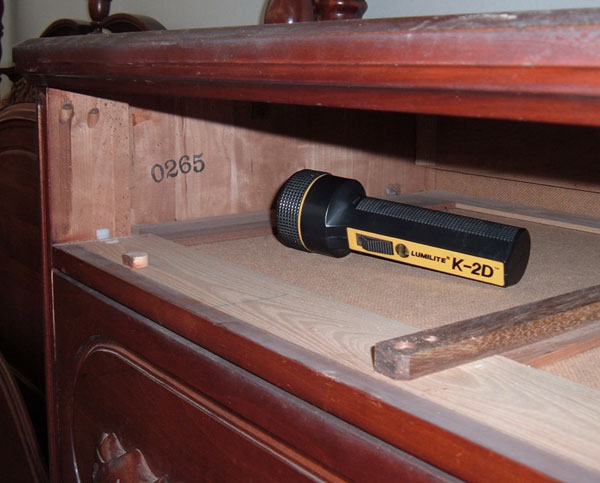
Date on case
� 02 65� means the item was made
in February of 1965
Sometimes the date is reversed.
� 65 02� also means February of 1965.
Dining tables and beds will not have the date stamp. Numbers on those items are usually only stock numbers or tracking codes during production.
If you can� t find anything that looks like a date of manufacture, and if the piece has been in your family, you might look for some old records. Don� t call us here. Since our sales are mainly to dealers, we don� t keep sales records for particular items. If you can� t find a date at all, then the age can only be estimated to within a decade.
Q: How do I know that my piece is made by Davis Cabinet?
A: Davis Cabinet Company has used a variety of labels over the years. However, there have been many imitators of Davis Cabinet. Sometimes, local dealers bought from other factories and told their customers that the product was made by Davis. Although most did not put a fake label in their product, some of the furniture copies look good at first glance.
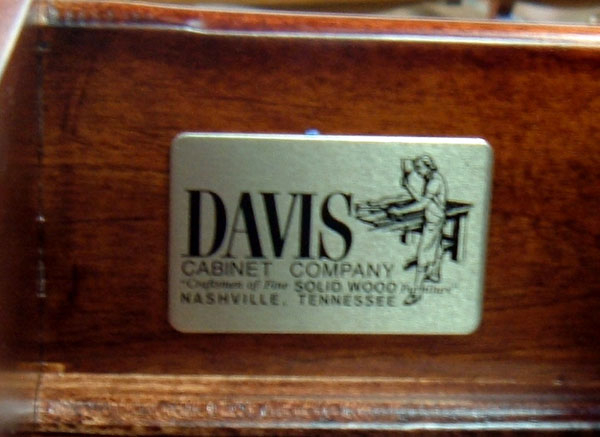
Brass Plate Currently Used
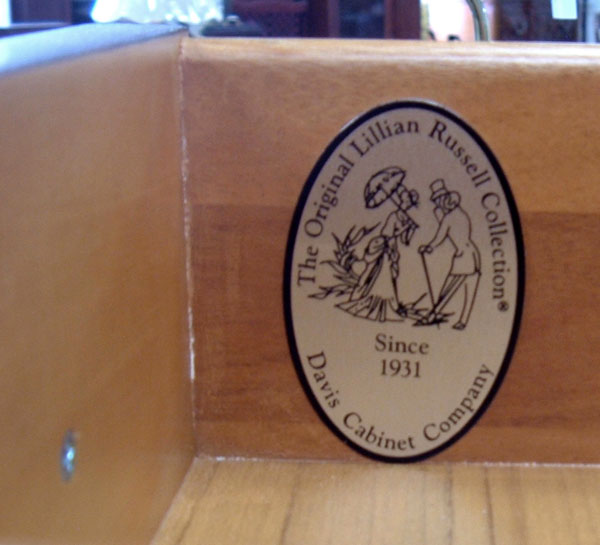
Brass Plate Lillian Russell Currently Used

Brass Plate Old Style
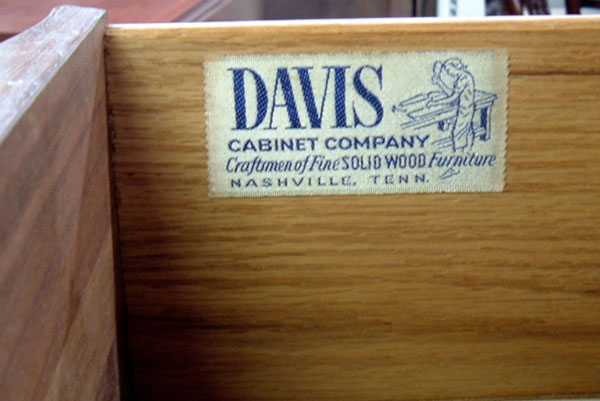
Cloth Label inside drawer
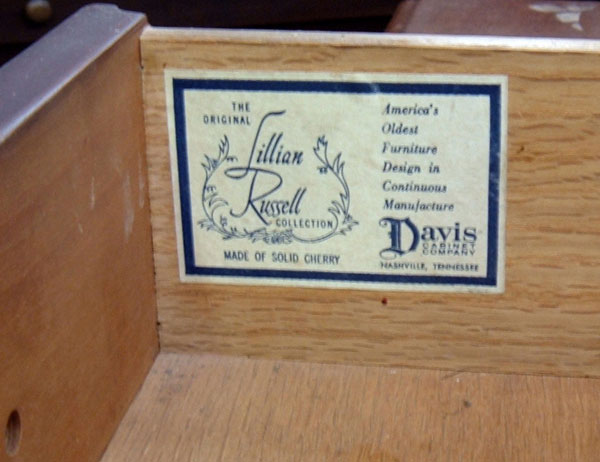
Paper Label inside drawer
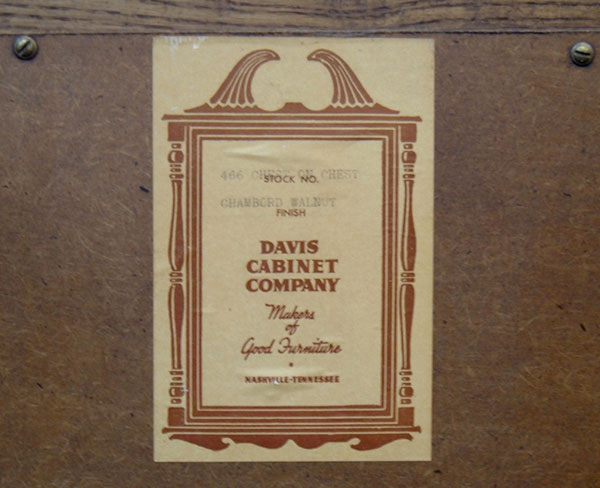
Paper Label on back of case
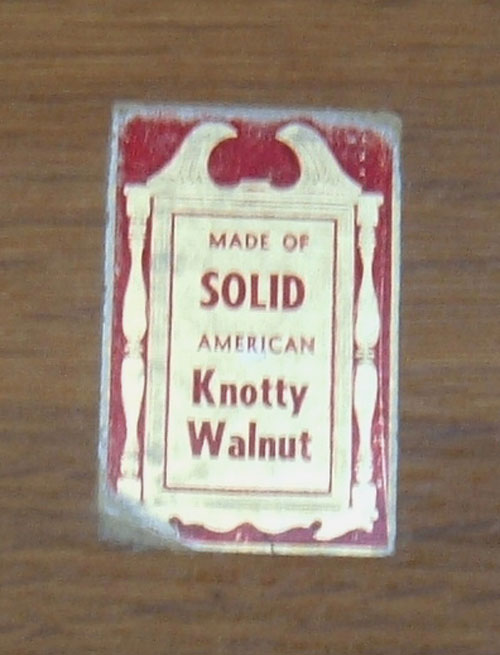
Paper Label to identify wood&finish
Recently, a family brought in a bedroom suite for refinishing that had been in the family for over forty years. They even brought an old sales ticket from a local furniture store that is now long out of business. The bill of sale specified Davis Cabinet, yet it was clear that it was not a Davis Cabinet product. Imagine their surprise and disappointment!
Look very carefully at the details of the piece to be sure it matches exactly the styles that Davis Cabinet produced over the years. And, look for those labels!
However, if your furniture was not made by Davis Cabinet, it may be quite valuable anyway. Old solid-wood furniture in good condition has lasting value, regardless of where it was made, and even if it needs refinishing.
Q: What is the style of my Davis furniture?
A: Davis Cabinet has made dozens of styles of furniture since our founding in 1929. Two of the older lines are in current production:
Lillian Russell ®, in continuous production since 1931
Cumberland Valley "!, in continuous production since 1936
These two lines may be viewed on the Web Site www.daviscabinetcompany.com.
Most Davis furniture does not have the style line shown on the label. Stock numbers found on the label or stamped on the furniture will be helpful. Look all over the item for these numbers. However, stock numbering systems changed over the years, so a stock number will not determine the style with absolute certainty. If the furniture has been in the family, someone may recall the name of the style.
Q: Where can I get replacement hardware for Davis furniture?
A: Davis Cabinet does not maintain at stock of hardware for furniture that is no longer made.
Keeler Brass Co., a Division of Hickory Hardware, specializes in replacement hardware.
Please contact:
Hickory Hardware/Keeler Brass
3100 Broadway Avenue, SW
Grandville, Michigan 49418
Office Hours: 8:00 AM � 4:00 PM, Monday-Friday
Phone: 1-800-874-6522, Ext. 4444
Be prepared to provide information about your furniture, including any identifying numbers on the hardware itself.
Q: I need to have my furniture refinished or restored. What do I do?
A: Most Davis Cabinet furniture has high residual value. Unless you have experience repairing and refinishing furniture, we recommend that you seek a professional for other than minor touch-up. Consult your local telephone business directory or go online for help. One source we have identified is
National Furniture Repair and Restoration HOTLINE
Email: furniturehotline@msn.com
Web Site: http://www.furniture-hotline.com
The Furniture Hotline is a free, national referral service which is also used by insurance companies. When you email them, please include your zip code, and an operator will provide you with the name of an authorized furniture repair and restoration professional.
Q: Can I buy finishes from Davis Cabinet?
A: No, we do not maintain of stock of materials for sale. All finishing materials are custom mixed for use at the factory.
If you need to refinish a Davis piece, it is safest to consult a furniture repair and refinishing professional in your area. They may be able to approximate the original finish of your piece. However, specialized finishes can be very difficult to replicate. These include painted finishes and multi-layer finishes with shadowing or � age� flecks.
The National Furniture Repair and Restoration HOTLINE is a free referral service that will give you the name of an authorized local professional. Email them at furniturehotline@msn.com or go to their web site at
http://www.furniture-hotline.com
For scratches and small areas, check with a local hardware store or a national chain such as Lowe� s or Home Depot. They will have a selection of touch-up markers. Be sure to test all finish materials on another board or an out-of-sight surface of your furniture to see how well the finish matches.
Q: What is a wood species?
A: Wood species refers to the wood used in manufacturing a piece of furniture. Although the majority of older Davis pieces were made in cherry wood, different lines were made of many species: ash, oak, black walnut, birch, and mahogany. Lines were often made in different wood species and finished in different colors. Production materials sometimes changed due to availability of the wood species.
Over the years, Lillian Russell ® and Cumberland Valley "! furniture has been made in cherry, black walnut, and mahogany. All new Lillian Russell ® and Cumberland Valley "! furniture made today is manfuctured in mahogany.
Some manufacturers advertise, for example, a � cherry finish,� but that does not necessarily mean that that the furniture is made of cherry wood. Most wood species can be finished in many colors. There is no such thing as a single � cherry finish.� Color and wood species are two different things, and we at Davis Cabinet try to describe our own furniture as accurately as we can.
Wood species may be marked on Davis furniture, either with an ink stamp or on a label, which may be on the back, bottom, or inside a drawer. Anytime you see a finish label that includes a wood species name, then the item is made of that wood species. Davis Cabinet has never used wood species names to label a color finish. If the Davis label says � Antique Walnut,� then you can be sure that the furniture is made of walnut.